SIREN (some poetics)
Amant, Brooklyn, NY
September 15, 2022–March 5, 2023
by Farren Fei Yuan
The exhibition SIREN (some poetics) that was unveiled this fall at Amant in East Williamsburg, Brooklyn offers an evocative experience that dissolves the boundaries in sensory perception and artistic media. As such, it posits an alternative to the proliferation of Instagram-ready exhibitions that are focused on creating spectacles and repackaging works of art into reified commodity forms.
Founded in 2019 as a non-profit arts organization, Amant acts at once as a studio space for young artists and an exhibition space, aiming, most importantly, “to slow down the art-making process.”1 SIREN, for example, takes place in the multiple spaces of the gallery that spans across Maujer Street and envelops a courtyard garden. In contrast to exhibitions that simply present information to be received, visitors to Amant are led to make their own discoveries: inadvertently walking into the uncanny installation of a tire, an umbrella, and a school desk, or catching the sounds of bell chimes in the distance (figs. 1 and 2). These outdoor works embed poetics in the everyday.
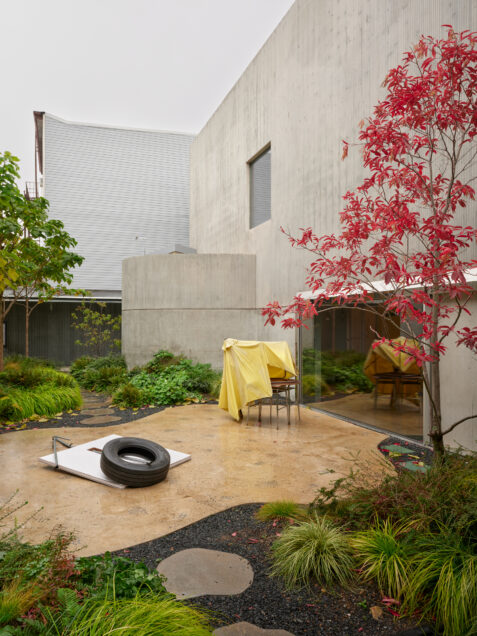
SIREN is accompanied by a series of performances, poetry readings, “learnshops,” and creative writing workshops that take place during the exhibition period, in various spaces across the buildings. The ideas generated from these multi-disciplinary and open-ended activities become incorporated into one’s understanding of the artworks. SIREN takes place within a larger stream of everyday activities, meaning that the exhibition is “read,” “written,” and “narrated” even if it is also “seen.” SIREN encounters its audience on an individual level, through a private, slow, and multi-sensory experience. Visuality as the privileged mode of engaging with art is challenged by a range of activities that interpenetrate the gallery space.2
The dismantling of hierarchical categories of perception and knowledge has strong thematic resonance with SIREN. As Quinn Latimer writes, the siren which sounds “over land [and] across water” stands for both an emittance that establishes perceptual, linguistic, social, and territorial borders and as an expansive call that stretches across uneven terrains.3 This double-sided notion of drawing and erasing boundaries, at once disciplining and liberating, underpins the concerns of the works featured in the exhibition. The seventeen participating artists work freely in watercolor, drawings, textiles, sculptural installations, videos, and the written word, to interrogate the idea of the siren across domains and temporalities: as a figure of myths, songs, and poetry as well as of technology.
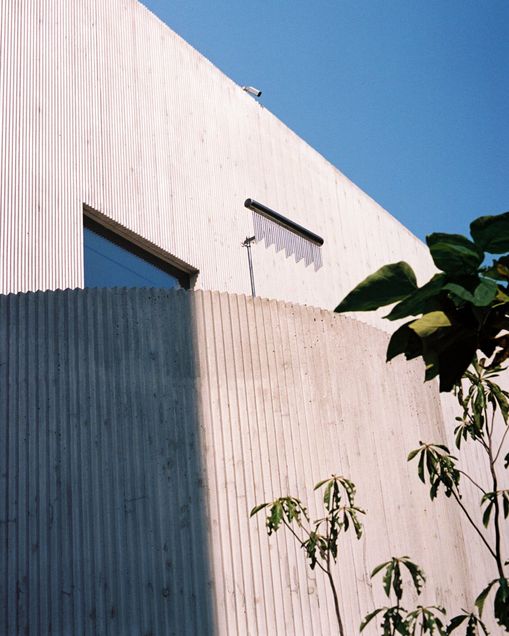
Lilian Lijn’s Queen of Hearts, Queen of Diamonds (1980), a pair of optical glass prisms whose three facets extend out through a tower of aluminum plates, are set apart, each emitting light that cuts across the space and interacts with the gallery lighting. Fetishized figures of patriarchal female archetypes and goddesses from Ancient Greek, Hindu, and Indigenous mythologies are dissipated into an assemblage of visual forms, texts, sound, volumes, and light that refuses to unify into an intelligible form. Their elusive bodies take the form of metallic pyramids under ample light (fig. 3) to flickering conical silhouettes in darkness (fig. 4), resisting capture by the objectifying gaze.
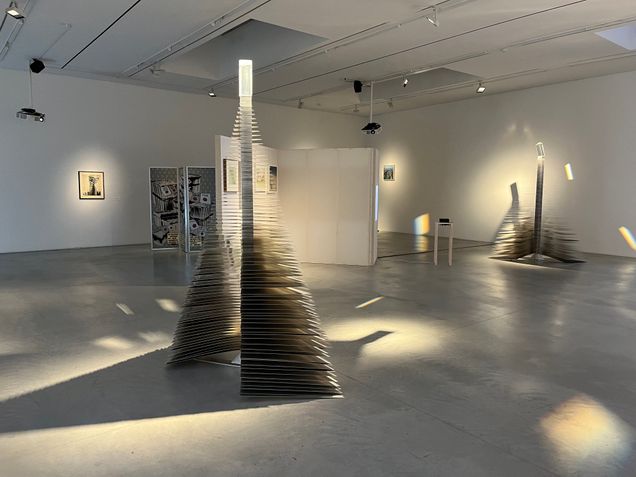
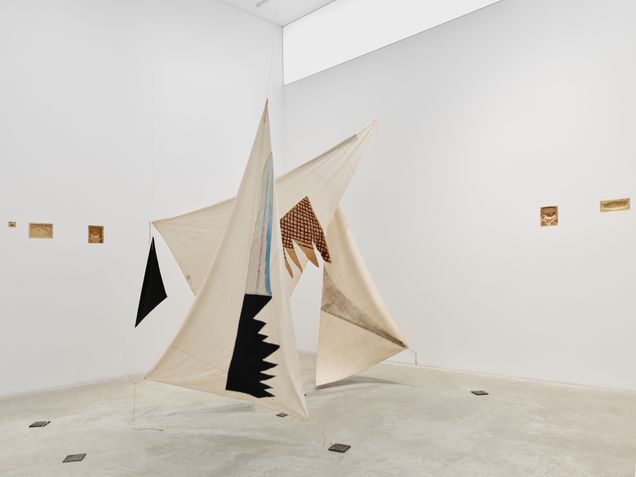
If Lijn works towards the dissolution of reified forms (both actual and figurative), other artists in the exhibition affront the visitor with sensoralities of the abject, thereby frustrating any attempt to spectacularize, reducing the exhibition into a pleasing yet inconsequential image. The most subtle example is a work by Patricia L. Boyd who has collected grease from restaurant leftovers, then used these materials to create negative casts of office items bought at a liquidation auction (fig. 5). The casts constitute a lexicon of rejects, the material evidence of the failures and excesses of contemporary society. However, these casts are embedded in the gallery walls, well above eye-level, such that their texture and form cannot be discerned. Boyd often works with “boundaries and thresholds”: the Borrowed Times series here introduces the abject (literally) into the institutional structure of the gallery and challenges the threshold of the visitor’s comfort.4
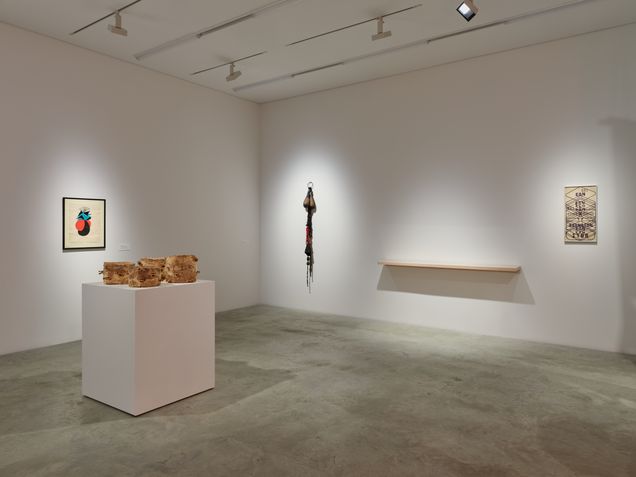
Such materiality of degeneration and decay is also palpable in Senga Nengudi’s R.S.V.P: Reverie-Combat Fatigue (1977/2011) in which hanging nylon stockings capture the material experience of the female body in its most deject, subversive state; or Nour Mobarak’s Fugue I and Fugue II (2019) where cultivated fungi cover two speakers whose multi-layered poetic recordings reflect upon history and memory (fig. 6). Addressing other dimensions of society, other artists in the exhibition turn moments of system failure into poetic allegories. Rivane Neuenschwander visualizes a possible glitch in communication in her textile piece, The Silence of the Sirens (2013) (fig. 7), a poetic constellation that emerges over a geometric grid, drifting between registers of sound and language: “silence,” “siren,” “SS,” “ssss(h).” The muted emptiness of the woven ground, and the refusal of the letters to give in to intelligible language, posit the mythical power of silence: as in Kafka’s parable referred to in the title, perhaps Odysseus survives because the sirens did not sing.
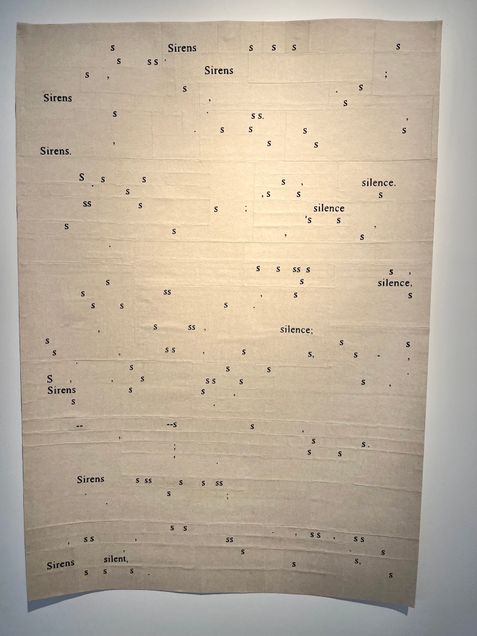
Making system failures visible exposes the problems and contradictions that would otherwise be simply smoothed over to produce an impression of successful operation. The artist collective Shanzhai Lyric, for example, composes poems out of counterfeit goods, consumer detritus, and theft practices (fig. 8). In Iris Touliatou’s HAPPINESS, 2018-2022 (to Laurie) (2022), a small display screen is held in place on a wall by the frame of an egg carton (fig. 9). Captions pop up at intervals, synchronized via a custom-made software to the speed of incoming notifications from the artist’s unread Gmail inbox. The continuous generation of signs that overflow in an incoherent narrative dramatically plays out the fracturing of today’s user-consumer’s sense of self. These are further played out on a phallic formal structure that is made uncanny by empty carton slots, the shadow cast on the wall, and the reflection of the viewer on the dark screen. The comfortably distant and secure position of the viewer that the spectacle relies on for its ideological functioning is disturbed.


SIREN posits the un-form, the abject, and the glitch as ways to practice contemporary poetics. The subversive power of the works is subtly embedded in their poetic beauty, like the deceptive charm of sirens, confronting the visitors and thereby resuscitating their experience. In a society of hyper-mediation, we need more exhibitions like SIREN which provoke us to reexamine and rethink common perceptions.
____________________
Farren Fei Yuan is an aspiring art researcher and critic. She graduated with a first class in BA in History of Art from The University of Oxford and is currently pursuing an MA in Modern and Contemporary Art: Critical and Curatorial Studies at Columbia University. Yuan has a special interest in image-text relations and post-war visual culture in the global context.
____________________
Footnotes
1. “About,” Amant, accessed December 10, 2022, https://www.amant.org/about.
2. This challenge to the assumptions underlying our conceptions of different activities is a strategy Rancière puts forth as an alternative to the rigidified practice of mixed media and interdisciplinarity. See Jacques Rancière, “The Emancipated Spectator,” in The Emancipated Spectator (London: Verso, 2021), 22.
3. Quinn Latimer, “SIREN (some poetics) [exh. guide],” Brooklyn, New York: Amant, 2022.
4. Patricia L. Boyd, “Contact Barrier: Patricia L. Boyd,” by Dora Budor, Mousse Magazine, July 5 2021, https://www.moussemagazine.it/magazine/patricia-l-boyd-dora-budor-2021/.